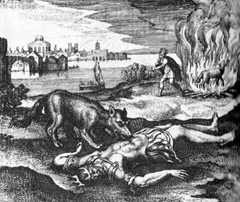Applied Psychoanalysis > Fairy Tales |
Psychoanalysis and Fairy Tales
By J Jones
A definition of the fairy tale should include the idea of artistic creation and also the one of aspiration of the human soul. Therefore, a collective aspiration which found a way of expressing itself through what we call fairy-tale (a form of written and oral literature).
Of course, another
characteristic feature of fairy tale is its fantastic structure. In fairy tales we find supernatural beings and experiences. That's why fairy tale had among its functions one related to the pleasure of following stories in which
the borders of the sensitive world are overreached. Although, beyond its fantastic character we find aspirations without anything fantastic, shared by people (or by collective soul). In the fairy tale
Youth without Aged and Life without Death
we find collective and individual aspirations. The hero's birth in this fairy tale brings about the messianic expectations of the people: people hoped to have an intelligent/enlighten ruler as Emperor Solomon.. But the hero doesn't taste the public life and chooses the search of immortality as the ideal of his ego.
The fairy tale explains us that at birth the child was crying in his mother's belly and that's why, in order to calm him, he was promised eternal youth and immortality. At the age of adolescence, he refuses any social
temptation and asks his parents to keep their promise. Thus he goes in search of this ideal, helped by the supernatural horse and by many other magic instances. At first sight, the analysis of this fairy tale doesn't raise any
difficulties - it is not about unconscious wishes, but about clear ideals. But psychoanalysis doesn't linger on the level of the ego's analysis. It pierces through the crust of appearance and deepens in the investigation of the
unconscious processes. There, in the depth of the unconscious mind it finds the resorts of the conscious world, of the motives consciously stated. In our case, the hero's wish must be understood differently as relating to
his refuse to grow up. The title of the fairy-tale may be also translated as it follows: "Forever Young". But what does this mean? A life fixed at the first years level, when the child lives in osmosis with his mother, who
offers him protection and food without asking nothing in exchange. His whole All psychoanalysts do not, of course, admit this interpretation. -- Jung states explicitly that fairy tales as well as myths are collectively elaborated fragments of some inner experiences which are alike in all respects with what he
called individuation process.
The wolf as prima materia devours the dead King; in the background: the sublimation of prima materia and king's rebirth (click here to enlarge) |
The symbol of the emperor is often used in alchemist literature where it gets various meanings. There, for example, it represents an ego incarnation which changes during the individuation process - in symbolic terms it dies in order to born again, renewed.
There is a picture published in the Jung's book Psychology and Alchemy showing this process (see it above) and bearing the following text: The wolf as prima materia devours the dead King; in the background: the sublimation of prima materia and the king's rebirth.
The king's rebirth - under the shape of the king's young son (placed in the background of the picture) - represents the Ego's rebirth that was restructured through the infusion of a new spirit-ghost. It is the crowning of the individuation process, when the ego integrates the contents of the archetypal unconscious.
Note.
Alchemical studies and experience don't take into account the fate o the psychological ego, meaning the person and his/her features that made everybody an individual. Thus, the King of
the alchemical resurrection doesn't symbolized the ego but God or the spirit of God (ruah) according to the Christian religion. Therefore the aim of alchemical proceedings is the resurrection of God himself and his power/grace.
Unfortunately, this concept is missing in the modern Christianity.
--
![]()
<= Back to the Applied Psychoanalysis or to the
Copyright 2002-2025, AROPA. All rights reserved.
